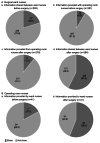Nurses' Recognition and Care of Thirst in Perioperative Patients in Japan
- PMID: 39886711
- PMCID: PMC11779687
- DOI: 10.7759/cureus.76624
Nurses' Recognition and Care of Thirst in Perioperative Patients in Japan
Abstract
Purpose: Postoperative thirst is common and distressing to patients, as is pain and nausea. The causes of postoperative thirst are complex and include factors like preoperative fasting, perioperative fluid loss, and certain anesthesia medications. Effective care for postoperative thirst has been shown in post-anesthesia care units (PACUs), but many Japanese hospitals lack PACUs or do not address thirst in their PACUs. Therefore, cooperation between the operating room and ward nurses is crucial for providing proper care for postoperative thirst. The purpose of this study was to clarify the actual situation of ward nurses' and operating room nurses' recognition and care of thirst in postoperative patients.
Methods: The study was a cross-sectional survey conducted using a self-administered questionnaire based on previous research. Study participants were nurses working in surgical wards and operating rooms of two university-affiliated hospitals. The survey items included (1) participants' characteristics, (2) recognition of thirst in perioperative patients, and (3) actual care provided to perioperative patients for thirst. Data were collected between September and October 2022 and subjected to descriptive and bivariate analysis.
Findings: A total of 298 ward nurses and 43 operating room nurses were included in the study. Among the observation items, thirst was observed least frequently. Both ward nurses and operating room nurses recognized patient thirst based on complaints rather than physical observations. Sharing of information about patient thirst differed between ward nurses and operating room nurses. None of the participants used scales or scores to evaluate thirst. The most common postoperative care in the ward was "They were asked to do a mouthwash with water," while in the operating room, it was "Placed a moistened gauze against the mouth." The reasons for selecting a particular type of care were primarily based on "Because of the patient's wishes" and "I think it is effective," while the reasons for not providing care included "Because there is an instruction not to drink water," "Due to the possibility of aspiration," "I don't have the knowledge and don't know how," and "I'm busy with other work."
Conclusions: Regarding the recognition of thirst, both ward nurses and operating room nurses recognized patient thirst most often when the patient directly reported feeling thirsty. They relied more on patients' verbal complaints than physical observations to recognize thirst. Both surgical ward nurses and operating room nurses provided care based on their experience.
Keywords: nursing research; post-anesthesia care unit; postoperative thirst; quality-of-care; recognition.
Copyright © 2024, Hanashiro et al.
Conflict of interest statement
Human subjects: Consent for treatment and open access publication was obtained or waived by all participants in this study. Yokohama City University Research Ethics Committee for Life Sciences and Medicine issued approval No. F220900001. Animal subjects: All authors have confirmed that this study did not involve animal subjects or tissue. Conflicts of interest: In compliance with the ICMJE uniform disclosure form, all authors declare the following: Payment/services info: Research grant from the Yokohama Academic Foundation. Financial relationships: All authors have declared that they have no financial relationships at present or within the previous three years with any organizations that might have an interest in the submitted work. Other relationships: All authors have declared that there are no other relationships or activities that could appear to have influenced the submitted work.
Figures



Similar articles
-
Assistant nurses' experiences of thirst and ethical dilemmas in dying patients in specialized palliative care-A qualitative study.J Adv Nurs. 2023 Nov;79(11):4292-4303. doi: 10.1111/jan.15851. Epub 2023 Sep 11. J Adv Nurs. 2023. PMID: 37694685
-
Newly trained operating room nurses' experiences of nursing care in the operating room.Scand J Caring Sci. 2020 Dec;34(4):1074-1082. doi: 10.1111/scs.12817. Epub 2020 Jan 15. Scand J Caring Sci. 2020. PMID: 31943310
-
Turkish surgical nurses' attitudes related to patient safety: A questionnaire study.Niger J Clin Pract. 2020 Apr;23(4):470-475. doi: 10.4103/njcp.njcp_677_18. Niger J Clin Pract. 2020. PMID: 32246652
-
Nurses' work experiences in hospital wards with single rooms: An integrative review.J Clin Nurs. 2023 Oct;32(19-20):7036-7049. doi: 10.1111/jocn.16824. Epub 2023 Jul 18. J Clin Nurs. 2023. PMID: 37462296 Review.
-
Respiratory Distress after Neck Surgery: Two Cases of Postoperative Cervical Hematoma.2023 Feb 1. In: WebM&M: Case Studies [Internet]. Rockville (MD): Agency for Healthcare Research and Quality (US); 2019 Oct 30–. 2023 Feb 1. In: WebM&M: Case Studies [Internet]. Rockville (MD): Agency for Healthcare Research and Quality (US); 2019 Oct 30–. PMID: 40106606 Free Books & Documents. Review. No abstract available.
References
-
- Evaluation of the intensity and discomfort of perioperative thirst. Pierotti I, Fracarolli IFL, Fonseca LF, Aroni P. Escola Anna Nery. 2018;22:0.
-
- Assessment strategies for the management of thirst in the post-anesthetic recovery room. Aroni P, Nascimento LAD, Fonseca LF. Acta Paul Enferm. 2012;25:530–536.
-
- Perioperative thirst: an analysis from the perspective of the Symptom Management Theory. Conchon MF, Nascimento LA, Fonseca LF, Aroni P. Rev Esc Enferm USP. 2015;49:122–128. - PubMed
-
- Practice of perioperative oral management. Kishimoto H. Jpn J Oral Maxillofac Surg. 2017;63:9–14.
LinkOut - more resources
Full Text Sources
